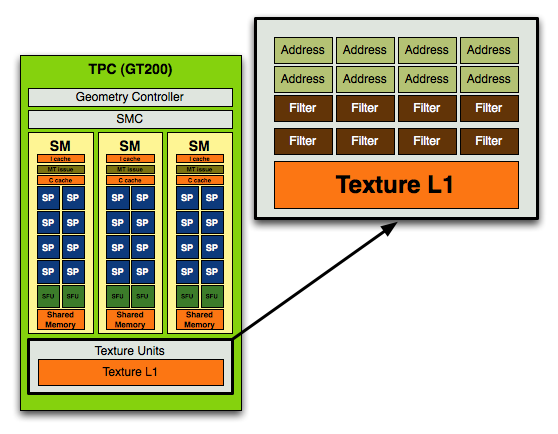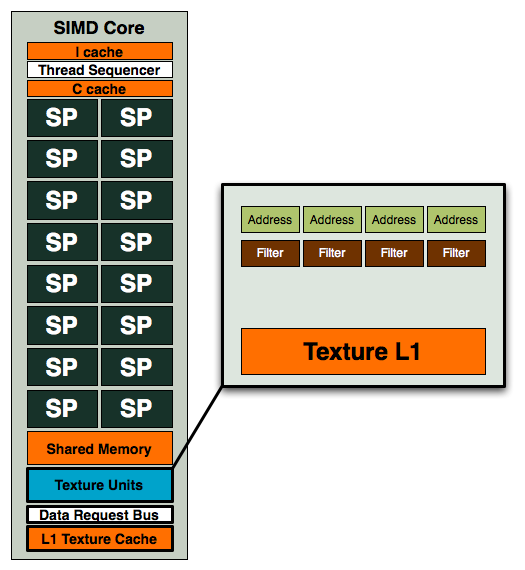The Radeon HD 4850 & 4870: AMD Wins at $199 and $299
by Anand Lal Shimpi & Derek Wilson on June 25, 2008 12:00 AM EST- Posted in
- GPUs
That Darn Compute:Texture Ratio
With its GT200 GPU, NVIDIA increased compute resources by nearly 90% but only increased texture processing by 25%, highlighting a continued trend in making GPUs even more powerful computationally. Here's another glance at the GT200's texture address and filter units:

Each TPC, of which there are 10, has eight address and eight filter units. Now let's look at RV770:

Four address and four filter units, while AMD maintains the same 1:1 address-to-filter ratio that NVIDIA does, the ratio of compute-to-texture in RV770 is significantly higher.
| AMD RV770 | AMD RV670 | NVIDIA GT200 | NVIDIA G92 | |
| # of SPs | 160 | 64 | 240 | 128 |
| Texture Address/Filter Units | 40 / 40 | 16 / 16 | 80 / 80 | 64 / 64 |
| Compute to Texture Ratio | 4:1 | 4:1 | 3:1 | 2:1 |
The table above illustrates NVIDIA's trend of increasing the compute to texture ratio from 2:1 in G92 to 3:1 in GT200. AMD arguably overshot with RV670 and its 4:1 ratio and thus didn't need to adjust it with RV770. Even while staying still at 4:1 with RV770, AMD's ratio is still more aggressively geared towards compute than NVIDIA's is. That does mean that more texture bound games will do better on NVIDIA hardware (at least proportionally), while more compute intensive games may do better on RV770.
AMD did also make some enhancements to their texture units as well. By doing some "stuff" that they won't tell us about, they improved the performance per mm^2 by 70%. Texture cache bandwidth has also been doubled to 480 GB/s while bandwidth between each L1 cache and L2 memory is 384 GB/s. L2 caches are aligned with memory channels of which there are four interleaved channels (resulting in 8 L2 caches).
Now that texture units are linked to both specific SIMD cores and individual L1 texture caches, we have an increase in total texturing ability due to the increase in SIMD cores with RV770. This gives us a 2.5x increase in the number of 8-bit per component textures we can fetch and bilinearly filter per clock, but only a 1.25x increase in the number of fp16 textures (as fp16 runs at half rate and fp32 runs at one quarter rate). It was our understanding that fp16 textures could run at full speed on R600, so the 1.25x increase in performance for half rate texturing of fp16 data makes sense.
Even though fp32 runs at quarter rate, with the types of texture fetches we would need to do, AMD says that we could end up being external memory bandwidth bound before we are texture filtering hardware bound. If this is the case, then the design decision to decrease rates for higher bit-depth textures makes sense.
| AMD RV770 | AMD RV670 | |
| L1 Texture Cache | 10 x 16KB (160KB total) | 32KB |
| L2 Texture Cache | I can has cache size? | 256KB |
| Vertex Cache | ? | 32KB |
| Local Data Share | 16KB | None |
| Global Data Share | 16KB | ? |
Even though AMD wouldn't tell us L1 cache sizes, we had enough info left over from the R600 time frame to combine with some hints and extract the data. We have determined that RV770 has 10 distinct 16k caches. This is as opposed to the single shared 32k L1 cache on R600 and gives us a total of 160k of L1 cache. We know R600's L2 cache was 256k, and AMD told us RV770 has a larger L2 cache, but they wouldn't give us any hints to help out.










215 Comments
View All Comments
jALLAD - Wednesday, July 9, 2008 - link
well I am looking forward to a single card setup. SLI or CF is beyond the reach of my pockets. :PGrantman - Friday, July 4, 2008 - link
Thank you very much for including the 8800gt sli figures in your benchmarks. I created an account especially so I could thank Anand Lal Shimpi & Derek Wilson as I have found no other review site including 8800gt sli info. It is very interesting to see the much cheaper 8800gt sli solution beating the gtx 280 on several occasions.Grantman - Friday, July 4, 2008 - link
When I mentioned "no other review site including 8800gt sli info" I naturally meant in comparison with the gtx280, gx2 4850 crossfire etc etc.Thanks again.
ohodownload - Wednesday, July 2, 2008 - link
computer-hardware-zone.blogspot.com/2008/07/ati-radeon-hd4870-x2-specification.tml
DucBertus - Wednesday, July 2, 2008 - link
Hi,Nice article. Could you please add the amount of graphics memory on the cards to the "The Test" page of the article. The amount of memory matters for the performance and (not unimportant) the price of the cards...
Cheers, DucBertus.
hybrid2d4x4 - Sunday, June 29, 2008 - link
Hello!Long-time reader here that finally decided to make an account. First off, thanks for the great review Anand and Derek, and hats off to you guys for following up to the comments on here.
One thing that I was hoping to see mentioned in the power consumption section is if AMD has by any chance implemented their PowerXpress feature into this generation (where the discrete card can be turned off when not needed in favor of the more efficient on-board video- ie: HD3200)? I recall reading that the 780G was supposed to support this kind of functionality, but I guess it got overlooked. Have you guys heard if AMD intends to bring it back (maybe in their 780GX or other upcoming chipsets)? It'd be a shame if they didn't, seeing as how they were probably the first to bring it up and integrate it into their mobile solutions, and now even nVidia has their own version of it (Hybrid Power, as part of HybridSLI) on the desktop...
AcornArmy - Sunday, June 29, 2008 - link
I honestly don't understand what Nvidia was thinking with the GTX 200 series, at least at their current prices. Several of Nvidia's own cards are better buys. Right now, you can find a 9800 GX2 at Pricewatch for almost $180 less than a GTX 280, and it'll perform as well as the 280 in almost all cases and occasionally beat the hell out of it. You can SLI two 8800 GTs for less than half the price and come close in performance.There really doesn't seem to be any point in even shipping the 280 or 260 at their current prices. The only people who'll buy them are those who don't do any research before they buy a video card, and if someone's that foolish they deserve to get screwed.
CJBTech - Sunday, June 29, 2008 - link
Hey iamap, with the current release of HD 4870 cards, all of the manufacturers are using the reference ATI design, so they should all be pretty much identical. It boils down to individual manufacturer's warranty and support. Sapphire, VisionTek, and Powercolor have all been great for me over the years, VisionTek is offering a lifetime warranty on these cards. I've had poor experiences with HIS and Diamond, but probably wouldn't hesitate to get one of these from either of those manufactures on this particular card (or the HD 4850) because they are the same card, ATI reference.Paladin1211 - Saturday, June 28, 2008 - link
Now that the large monolithic, underperforming chip is out, leaving AMD free to grab market share, I'm so excited at what to happen. As nVidia's strategy goes, they're now scaling down the chip. But pardon me, cut the GTX 280 in half and then prices it at $324.99? That sounds so crazy!Anyone remembers the shock treatment of AMD with codename "Thunder"? DAAMIT has just opened "a can of whoop ass" on nVidia!
helldrell666 - Friday, June 27, 2008 - link
Anand tech why didnt you use and amd 790FX board to bench the radeon cards instead of using an nvidia board for both nvidia and ATI cards.It would be more accurate to bench those cards on compatible boards .I think those cards would have worked better on an amd board based on the radeon express 790fx chipset.